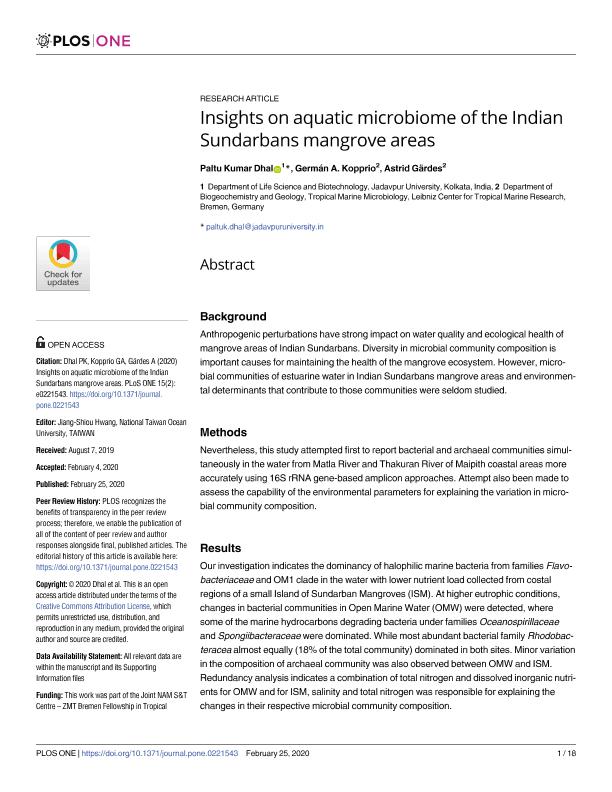Mostrar el registro sencillo del ítem
dc.contributor.author
Dhal, Paltu Kumar
dc.contributor.author
Kopprio, Germán Adolfo

dc.contributor.author
Gärdes, Astrid
dc.date.available
2021-06-16T11:47:13Z
dc.date.issued
2020-02-25
dc.identifier.citation
Dhal, Paltu Kumar; Kopprio, Germán Adolfo; Gärdes, Astrid; Insights on aquatic microbiome of the Indian Sundarbans mangrove areas; Public Library of Science; Plos One; 15; 2; 25-2-2020; 1-18
dc.identifier.issn
1932-6203
dc.identifier.uri
http://hdl.handle.net/11336/133966
dc.description.abstract
Background: Anthropogenic perturbations have strong impact on water quality and ecological health of mangrove areas of Indian Sundarbans. Diversity in microbial community composition is important causes for maintaining the health of the mangrove ecosystem. However, microbial communities of estuarine water in Indian Sundarbans mangrove areas and environmental determinants that contribute to those communities were seldom studied. Methods: Nevertheless, this study attempted first to report bacterial and archaeal communities simultaneously in the water from Matla River and Thakuran River of Maipith coastal areas more accurately using 16S rRNA gene-based amplicon approaches. Attempt also been made to assess the capability of the environmental parameters for explaining the variation in microbial community composition. Results: Our investigation indicates the dominancy of halophilic marine bacteria from families Flavobacteriaceae and OM1 clade in the water with lower nutrient load collected from costal regions of a small Island of Sundarban Mangroves (ISM). At higher eutrophic conditions, changes in bacterial communities in Open Marine Water (OMW) were detected, where some of the marine hydrocarbons degrading bacteria under families Oceanospirillaceae and Spongiibacteraceae were dominated. While most abundant bacterial family Rhodobacteracea almost equally (18% of the total community) dominated in both sites. Minor variation in the composition of archaeal community was also observed between OMW and ISM. Redundancy analysis indicates a combination of total nitrogen and dissolved inorganic nutrients for OMW and for ISM, salinity and total nitrogen was responsible for explaining the changes in their respective microbial community composition. Conclusions: Our study contributes the first conclusive overview on how do multiple environmental/ anthropogenic stressors (salinity, pollution, eutrophication, land-use) affect the Sundarban estuary water and consequently the microbial communities in concert. However, systematic approaches with more samples for evaluating the effect of environmental pollutions on mangrove microbial communities are recommended.
dc.format
application/pdf
dc.language.iso
eng
dc.publisher
Public Library of Science

dc.rights
info:eu-repo/semantics/openAccess
dc.rights.uri
https://creativecommons.org/licenses/by/2.5/ar/
dc.subject
WATER QUALITY
dc.subject
WETLAND
dc.subject
BACTERIA
dc.subject
ARCHAEA
dc.subject
NUTRIENT
dc.subject.classification
Oceanografía, Hidrología, Recursos Hídricos

dc.subject.classification
Ciencias de la Tierra y relacionadas con el Medio Ambiente

dc.subject.classification
CIENCIAS NATURALES Y EXACTAS

dc.subject.classification
Biología Celular, Microbiología

dc.subject.classification
Ciencias Biológicas

dc.subject.classification
CIENCIAS NATURALES Y EXACTAS

dc.subject.classification
Ciencias Medioambientales

dc.subject.classification
Ciencias de la Tierra y relacionadas con el Medio Ambiente

dc.subject.classification
CIENCIAS NATURALES Y EXACTAS

dc.title
Insights on aquatic microbiome of the Indian Sundarbans mangrove areas
dc.type
info:eu-repo/semantics/article
dc.type
info:ar-repo/semantics/artículo
dc.type
info:eu-repo/semantics/publishedVersion
dc.date.updated
2021-03-26T13:01:05Z
dc.journal.volume
15
dc.journal.number
2
dc.journal.pagination
1-18
dc.journal.pais
Estados Unidos

dc.journal.ciudad
San Francisco
dc.description.fil
Fil: Dhal, Paltu Kumar. Jadavpur University; India
dc.description.fil
Fil: Kopprio, Germán Adolfo. Consejo Nacional de Investigaciones Científicas y Técnicas. Centro Científico Tecnológico Conicet - Bahía Blanca. Instituto Argentino de Oceanografía. Universidad Nacional del Sur. Instituto Argentino de Oceanografía; Argentina. Leibniz Center for Tropical Marine Research; Alemania
dc.description.fil
Fil: Gärdes, Astrid. Leibniz Center for Tropical Marine Research; Alemania
dc.journal.title
Plos One

dc.relation.alternativeid
info:eu-repo/semantics/altIdentifier/url/https://journals.plos.org/plosone/article?id=10.1371/journal.pone.0221543
dc.relation.alternativeid
info:eu-repo/semantics/altIdentifier/doi/http://dx.doi.org/10.1371/journal.pone.0221543
Archivos asociados
